This article includes a list of references, related reading, or external links, but its sources remain unclear because it lacks inline citations .(April 2009) |
This page lists all peers who held extant titles between 1210 and 1219.
This article includes a list of references, related reading, or external links, but its sources remain unclear because it lacks inline citations .(April 2009) |
This page lists all peers who held extant titles between 1210 and 1219.
| Title | Holder | Date gained | Date lost | Notes |
|---|---|---|---|---|
| Earl of Mar (1114) | Gille Críst, Earl of Mar | Abt. 1178 | Abt. 1220 | |
| Earl of Dunbar (1115) | Patrick I, Earl of Dunbar | 1182 | 1232 | |
| Earl of Angus (1115) | Gille Críst, Earl of Angus | 1197 | Abt. 1210 | Died |
| Donnchadh, Earl of Angus | Abt. 1210 | 1214 | Died | |
| Máel Coluim, Earl of Angus | 1214 | 1240 | ||
| Earl of Atholl (1115) | Henry, Earl of Atholl | Abt 1190 | 1210 | Died |
| Isabella, Countess of Atholl | 1210 | Abt. 1231 | ||
| Earl of Buchan (1115) | Margaret, Countess of Buchan | Abt. 1195 | Abt. 1243 | |
| Earl of Strathearn (1115) | Gille Brigte, Earl of Strathearn | 1171 | 1223 | |
| Earl of Fife (1129) | Máel Coluim I, Earl of Fife | 1203 | 1228 | |
| Earl of Menteith (1160) | Muireadhach I, Earl of Menteith | Abt. 1190 | Abt. 1213 | Died |
| Muireadhach II, Earl of Menteith | Abt. 1213 | Abt. 1230 | ||
| Earl of Lennox (1184) | Ailín I, Earl of Lennox | 1184 | 1220 | |
| Earl of Carrick (1184) | Donnchadh, Earl of Carrick | 1186 | 1250 | |
| Earl of Ross (1215) | Fearchar, Earl of Ross | 1215 | 1251 | New creation |
| Title | Holder | Date gained | Date lost | Notes |
|---|---|---|---|---|
| Earl of Ulster (1205) | Hugh de Lacy, 1st Earl of Ulster | 1205 | 1242 | |
| Baron Athenry (1172) | Robert de Bermingham | 1172 | 1218 | Died |
| Peter de Bermingham | 1218 | 1244 |

Richard III was King of England from 26 June 1483 until his death in 1485. He was the last king of the Plantagenet dynasty and its cadet branch the House of York. His defeat and death at the Battle of Bosworth Field marked the end of the Middle Ages in England.
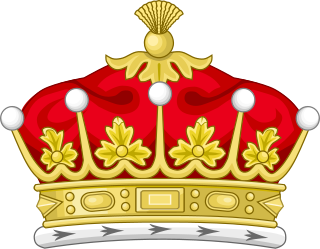
Earl of Albemarle is a title created several times from Norman times onwards. The word Albemarle is derived from the Latinised form of the French county of Aumale in Normandy, other forms being Aubemarle and Aumerle. It is described in the patent of nobility granted in 1697 by William III to Arnold Joost van Keppel as "a town and territory in the Dukedom of Normandy."

Earl of Leicester is a title that has been created seven times. The first title was granted during the 12th century in the Peerage of England. The current title is in the Peerage of the United Kingdom and was created in 1837.

Viscount Hereford is the oldest extant viscountcy in the Peerage of England, making the holder the Premier Viscount of England. The title was created in 1550 for Walter Devereux, 10th Baron Ferrers of Chartley.
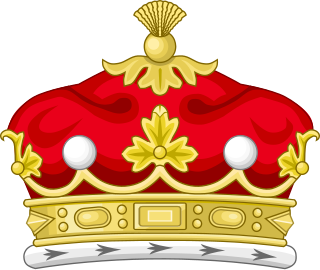
Marquess Townshend is a title in the Peerage of Great Britain held by the Townshend family of Raynham Hall in Norfolk. The title was created in 1787 for George Townshend, 4th Viscount Townshend.
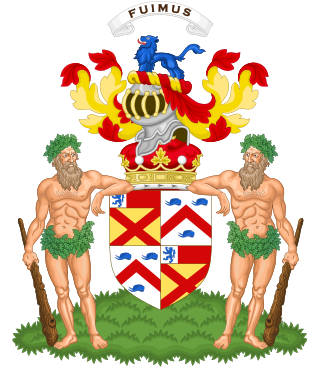
Marquess of Ailesbury, in the County of Buckingham, is a title in the Peerage of the United Kingdom. It was created on 17 July 1821 for Charles Brudenell-Bruce, 2nd Earl of Ailesbury.

Baron de Clifford is a title in the Peerage of England. It was created in 1299 for Robert de Clifford (c.1274–1314), feudal baron of Clifford in Herefordshire, feudal baron of Skipton in Yorkshire and feudal baron of Appleby in Westmoreland. The title was created by writ, which means that it can descend through both male and female lines. The Norman family which later took the name de Clifford settled in England after the Norman Conquest of 1066 and was first seated in England at Clifford Castle in Herefordshire. The first Baron served as Earl Marshal of England but was killed at the Battle of Bannockburn in 1314. His 8th generation descendant the 11th Baron, was created Earl of Cumberland in 1525, whose grandson the 3rd Earl was a noted naval commander. On the latter's death in 1605, the earldom passed to his younger brother, the 4th Earl.

Earl Howe is a title that has been created twice in British history, for members of the Howe and Curzon-Howe family respectively. The first creation, in the Peerage of Great Britain, was in 1788 for Richard Howe, 4th Viscount Howe, but it became extinct upon his death in 1799. The second creation, in the Peerage of the United Kingdom, was in 1821 for Richard Curzon-Howe, 2nd Viscount Curzon, and it remains extant.
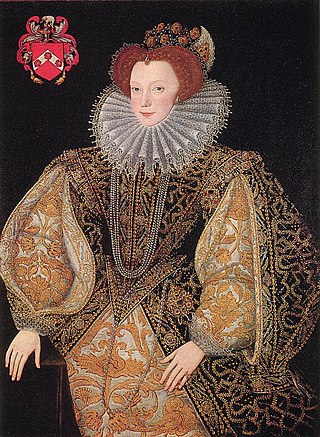
Lettice Knollys, Countess of Essex and Countess of Leicester, was an English noblewoman and mother to the courtiers Robert Devereux, 2nd Earl of Essex, and Lady Penelope Rich. By her second marriage to Elizabeth I's favourite, Robert Dudley, Earl of Leicester, she incurred the Queen's unrelenting displeasure.
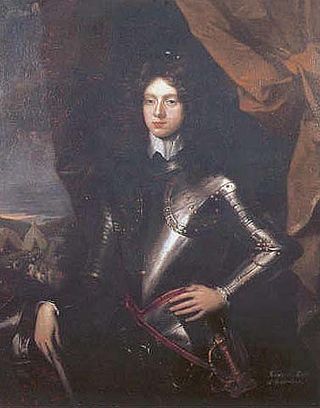
Henry Spencer, 1st Earl of Sunderland, 3rd Baron Spencer of Wormleighton, known as The Lord Spencer between 1636 and June 1643, was an English peer, nobleman, and politician from the Spencer family who fought and died in the English Civil War on the side of the Cavaliers.
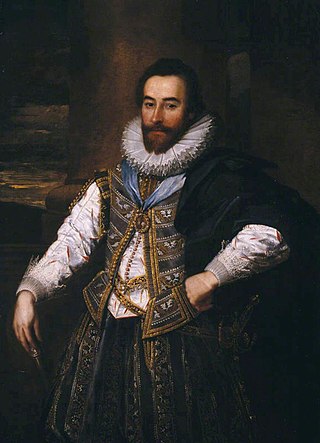
Robert Sidney, 2nd Earl of Leicester was an English diplomat and politician who sat in the House of Commons between 1614 and 1625 and then succeeded to the peerage as Earl of Leicester.
Maud of Lancaster, also known as Matilda, Countess of Hainault, was a 14th-century English noblewoman who married into the Bavarian ducal family.

George Townshend, 2nd Marquess Townshend, PC, FRS, known as The Lord Ferrers of Chartley from 1770 to 1784 and as The Earl of Leicester from 1784 to 1807, was a British peer and politician.

John Sheffield, 2nd Baron Sheffield, of Butterwick was an English nobleman.
There have been three baronetcies created for persons with the surname Noel, two in the Baronetage of England and one in the Baronetage of Great Britain. One creation is extant as of 2008.
Dermot Robert Wyndham Bourke, 7th Earl of Mayo was an Anglo-Irish peer, styled Lord Naas from 1867 to 1872, who served as an Irish representative peer in the British House of Lords (1890–1921) and member of the Senate of Southern Ireland (1921–1922) and Seanad Éireann (1922–1927).
Events from the year 1543 in Ireland.
Sir Charles Arundell, was an English gentleman, lord of the manor of South Petherton, Somerset, notable as an early Roman Catholic recusant and later as a leader of the English exiles in France. He has been suggested as the author of Leicester's Commonwealth, an anonymous work which attacked Queen Elizabeth's favourite, the Earl of Leicester.

Leicester House was a large aristocratic townhouse in Westminster, London, to the north of where Leicester Square now is. Built by the Earl of Leicester and completed in 1635, it was later occupied by Elizabeth Stuart, a British princess and former Queen of Bohemia, and in the 1700s by the two successive Hanoverian princes of Wales.